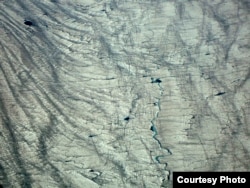The Greenland ice sheet seems to be melting faster than predicted, according to a new study published in the Proceedings of the National Academy of Sciences. This puts the world's coastal communities at greater risk sooner.
Greenland is a huge island. If it were a country, it would be a little larger than Saudi Arabia. Eighty percent of the island is covered by ice. If all of it melted completely, global sea level would rise more than seven meters.
Beata Csatho, an associate geology professor at the University of Buffalo, has been observing Greenland’s complexities, mining NASA data for 20 years. The study she led combined satellite and aerial data. The resulting analysis is the first comprehensive account of how the ice sheet and its many glaciers are changing.
Measurements at 1,000 locations
Prior to this work, scientists used data from models of four large glaciers to make forecasts for the entire island. The new study uses a much bigger data set, tracking surface elevation changes at 1,000 different locations.
“We all know that the ice is melting. We are losing ice," Csatho said. "But [our data] is also giving the spatial and the temporal pattern, which areas are more vulnerable, which areas are changing rapidly, which areas are changing in a different way than we expected.”
The scientists checked the new data against the current climate models for Greenland. Csatho says the old models are way too limited.
“Having more data, we can have a much more accurate way of understanding how the ice sheet is changing now and knowing that we can predict it more accurately what it will do in the future.”
Behavior varies among glaciers
These new insights suggest that in the near future, Greenland ice might melt faster than previously thought. The study finds that glaciers next to each other are not necessarily changing in the same way. Some grew thicker even when the temperature rose. Others exhibited accelerated thinning. Some displayed both thinning and thickening, with sudden reversals.
In analyzing the data, Csatho says researchers looked for patterns that took into account the effect of local hydrology and other factors, like the ocean temperature or water under a glacier.
“For example if the ice gets warmer, the glacier can flow faster. And that faster flow will deliver more ice into the ocean. We call it ice dynamics. It is a very important part of understanding what is happening. That is the way glaciers and ice sheets are responding to the change of climate.”
Csatho says the study shows why detailed, widespread monitoring is critical. Her team plans to track 242 glaciers in Greenland to build better models. And those models, she adds, can help coastal communities respond to rising seas









